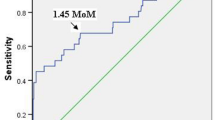Abstract
Aims
The cause of striae gravidarum is still unclear. The study objective was to test the hypothesis that relaxin is involved in the process of striae gravidarum appearance during pregnancy.
Methods
A prospective observational study in 32 pregnant women. Participants were observed at 12th, 24th and 36th gestational week. During each session, striae scoring was assessed and blood for relaxin estimation was withdrawn. The striae assessment was done according to Davey score. Serum relaxin was estimated using Relaxin ELISA kit (Immunodiagnostic AG, Bensheim, Germany).
Results
Serum relaxin levels decreased as the pregnancy advanced (585.9 ± 295.1, 424.2 ± 253.8, 402.1 ± 221.2 pg/ml, respectively) but this decrease did not attain statistical significance. Pregnant women with striae gravidarum had lower serum relaxin levels compared to those without striae gravidarum at 36th gestational weeks, 330.8 ± 175.2 vs 493.8 ± 245.8 pg/ml (P = 0.037), respectively. The severity of striae gravidarum during pregnancy did not correlate with serum relaxin levels.
Conclusion
Lower serum relaxin levels could contribute to the occurrence of striae gravidarum during pregnancy through decreased elasticity of the connective tissue.
Similar content being viewed by others
References
Salter SA, Kimball AB (2006) Striae gravidarum. Clin Dermatol 24:97–100
Davey CMH (1972) Factors associated with the occurrence of striae gravidarum. J Obstet Gynecol Br Commonw 79:1113–1114
Atwal GS, Manku LK, Griffiths CE, Polson DW (2006) Striae gravidarum in primiparae. Br J Dermatol 155:965–969
Chang AL, Agredano YZ, Kimball AB (2004) Risk factors associated with striae gravidarum. J Am Acad Dermatol 51:881–885
Liu DTY (1974) Striae gravidarum. Lancet I:625
Gillman T, Pillay RA (1959) Serum mucoproteins in African women during pregnancy, the puerperium. Surg Gynecol Obstet 109:709–715
Weiss G, Goldsmith LT, Sachdev R, Von Hagen S, Lederer K (1993) Elevated first trimester serum relaxin concentrations in pregnant women following ovarian stimulation predict prematurity risk and preterm delivery. Obstet Gynecol 82:821–828
Mac Lennan AH (1983) The role of relaxin in human reproduction. Clin Reprod Fertil 2:77–95
Vogel I, Salvig JD, Secher NJ, Uldbjerg N (2001) Association between raised relaxin levels during the eighteenth gestational week and very preterm delivery. Am J Obstet Gynecol 184:390–393
MacLennan AH, Nicolson R, Green RC (1986) Serum relaxin in pregnancy. Lancet 2(8501):241–243
Thomas RG, Liston WA (2004) Clinical associations of striae gravidarum. J Obstet Gynaecol 24:270–271
Rice BH (1962) Effect of the hormone relaxin on the periodontal tissues of animals primed with estrogen. J Dent Res 41:351–358
Kristiansson P, Samuelsson E, von Schoultz B, Svardsudd K (2001) Urinary stress incontinence in pregnancy. Acta Obstet Gynecol Scand 80:1125–1130
Acknowledgments
The study was partially supported by a Grant from the Israeli Society of Obstetrics and Gynecology in the Community.
Conflict of interest statement
We declare that we have no conflict of interest and we state that we have had full control of all primary data and agree to allow the journal to review the data if requested.
Author information
Authors and Affiliations
Corresponding author
Rights and permissions
About this article
Cite this article
Lurie, S., Matas, Z., Fux, A. et al. Association of serum relaxin with striae gravidarum in pregnant women. Arch Gynecol Obstet 283, 219–222 (2011). https://doi.org/10.1007/s00404-009-1332-5
Received:
Accepted:
Published:
Issue Date:
DOI: https://doi.org/10.1007/s00404-009-1332-5




